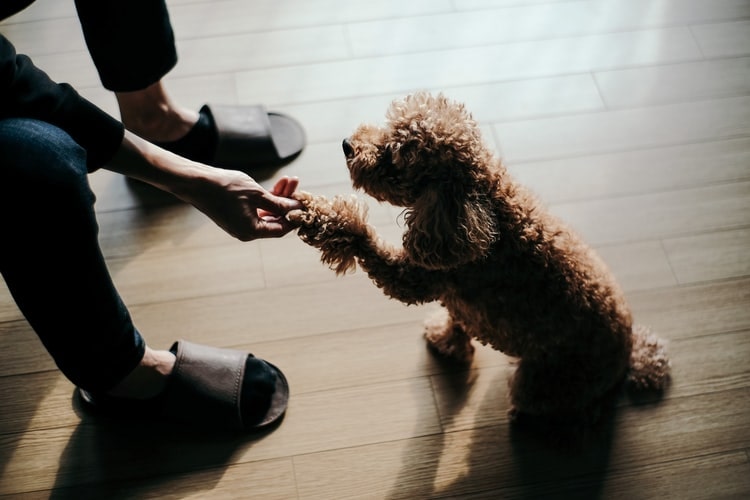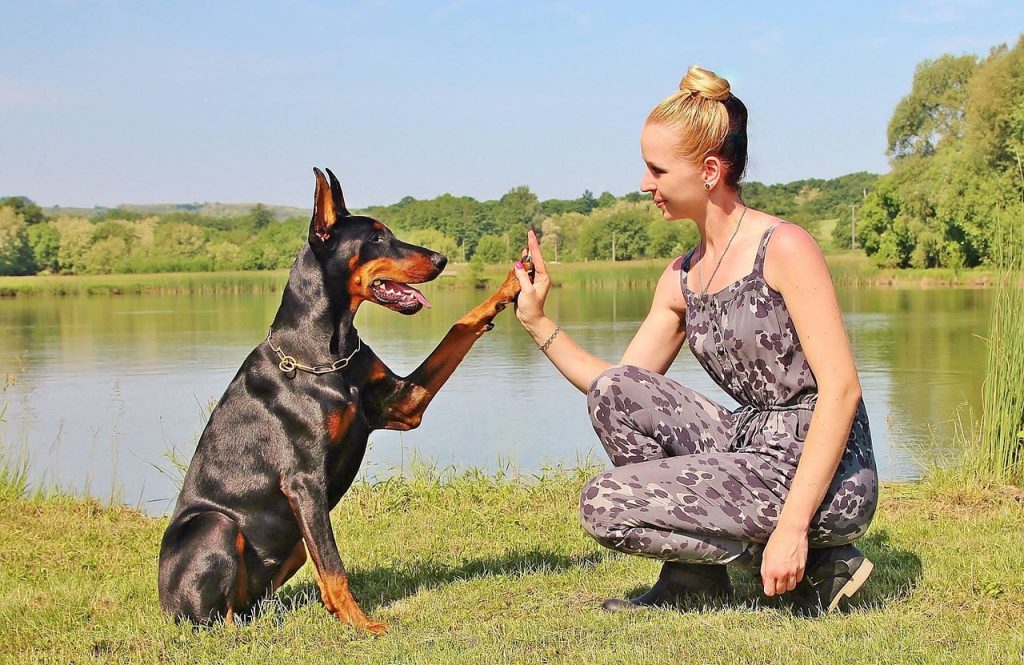The “Give paw!” command for dogs is often useful in life, so it may be worth spending time learning it.
Training is a purposeful preparation of a dog aimed at developing certain skills that may be mandatory or not. The “Give paw!” command, which does not have much functional value, belongs to the non-mandatory ones. Learning it is necessary for the overall development of the dog. Although often the command has a functional value and is useful in life, so it may be worth spending time teaching the pet this skill. It is possible to teach a dog the “Give paw!” command both in adulthood and as a puppy.
Why is this command necessary?
The ability to give a paw on command will help the pet subsequently learn other exercises that require the use of the front limbs. And in general, this simple command is great entertainment – for children, adults, and the dog itself.
Mastering the command will be useful in everyday life, for example, when caring for claws, washing paws, putting on shoes, and will contribute to strengthening the emotional contact between the owner and the pet.
To consolidate the skill, it needs to be regularly repeated. It’s easy to do this since the command doesn’t require going for a walk. Just don’t forget to ask the pet to give a paw, and then it will remember it for life.
At what age to start?
Not all dog owners start training their pets at the right time: sometimes a dog begins to learn the basics of training when it is already mature enough. Therefore, the method of teaching an animal the “Give paw!” command will be interesting to both puppy owners and owners of adult dogs.
Usually, you can teach a puppy the “Give paw!” command at a fairly young age, but dog trainers recommend starting training at five months old – after the baby has mastered the “Sit” command and can maintain composure for a longer period of time.
Although it all depends on the abilities of a particular pet – some learn well even at two months old, barely leaving their mother.
In general, there is no lower age limit for mastering the “Give paw!” command.

How to teach a dog to give paw?
As a rule, there are two main methods used to train the “Give paw!” command: motivation with treats and training without treats (mechanical influence). The third method, demonstrated by another four-legged animal, is additional, but works no worse than the first two.
With treats.
If the sequence of actions is followed precisely, it is possible to teach a dog the “Give paw” command in a couple of lessons.
- The first command given is “Sit!” or, in the case where the puppy is not yet familiar with basic commands, the student is seated with the help of the trainer.
- A person stands in front of the animal, holding a tasty and fragrant treat in their hand. The distance should be small (50-60 cm) – like an outstretched arm.
- Then you need to show the pet the reward and clench your palm. The second hand is in front of the dog at this time.
- When the pet tries to reach for the treat, it will lift its paw and hit the hand. At this point, you need to intercept it and clearly say “Give paw!” and open the palm of the other hand, giving the reward.
To practice the skill, the exercise should be repeated several times so that the pet forms an association of “command – lifting paw – reward”.
Without treats.
This method is also called physical impact. It is implemented through physical contact between the trainer and the dog:
- The trainer is positioned in front of the dog at a distance of about 60 cm, while the pet is in a sitting position.
- The owner carefully takes the pet’s paw into his hand and clearly says “Give paw!”
- You can gently push the dog’s paw forward to encourage it to lift it up. At that moment, take the paw in your hand, praise the dog with your voice, and give it a treat.
- You should repeat the action 2-3 times, and then make sure to give the animal a break.
Mastering the skill using this method may take a little more time, but you will be able to assess your pet’s trainability, intelligence, and obedience.
For example, using another dog.
Since teaching a dog to give paw is not always easy, you can use the help and obedience of another four-legged friend. This method of training is actively used in dog training. So, what do you need to do:
- Call your adult pet to you, give a command, and be sure to reward the dog with praise or a treat after it is completed.
- Call the puppy and give it the same command – “Give paw”. If the puppy does not understand what is required of it, repeat the command no more than two or three times.
- If the command is not executed, do not insist. Distract the dog with play and communication, and after a while repeat the training again.
Be persistent, but maintain a positive attitude, and after a couple of training sessions, your pet will understand what ‘Give paw’ means.
If you don’t have a second dog, you can ask other dog owners you know during a walk to help you. Choose the friendliest pet as a ‘mentor’.
How to teach a dog the ‘Other paw’ command?
You can expand your pet’s skillset by introducing the ‘Give the other paw!’ command. You should start teaching this command only after the initial one has been fully mastered.
Give the command. When the dog extends its paw, take it, encourage the execution with your voice and a treat, and release the paw. Then give the ‘Other paw’ command and take (or slightly push) the other paw, encouraging the execution.
The successful result should be reinforced: usually, dogs quickly understand the purpose of a new, but partially familiar command.
Several rules for training and reinforcement.
When training your pet, keep in mind the basic recommendations. They will allow you to achieve success much faster and easier. What do dog trainers recommend:
- The success of training largely depends on a positive and friendly attitude, when the owner shows due perseverance while remaining kind and calm.
- Exercises are carried out when the pet is in a good mood, alert and healthy. If something bothers the puppy – he feels unwell, he is tired – it will be difficult to achieve a positive result. Moreover, he may develop a negative attitude towards training.
- During training, there should be no distracting factors or external irritants. The “Give paw!” command can easily be practiced at home.
- Proper preparation for training is the key to achieving excellent and quick results. Never feed your puppy right before a lesson: it’s better to do it two hours earlier, otherwise he will not be motivated by treats. Tasty pieces should not be too large, otherwise the pet will quickly get full and lose interest in the training.
- It is not necessary to use non-basic commands in their standard form. You can modify the word form. For example, some dog owners use the command “Give me five!” The main thing is that the pet understands it and performs it correctly.
- Once you have chosen a command wording, do not change it. “Give paw” and “Let’s give paw” sound completely different to a dog.
It is important to conduct training sessions systematically, without overworking the pet, and alternating training with rest breaks. Five to six repetitions per day are quite sufficient for practicing skills.
How to avoid mistakes?
The livelihood of your pet does not depend on how well you can teach it to give paw, but this skill will elicit a more favorable attitude towards your furry friend from others. Additionally, the ability to give paw will come in handy when trimming nails and washing paws after a walk.
If you have decided to train your dog yourself, it is important not to overdo it. There are several serious mistakes to avoid in the training process:
- When teaching the “paw” command to a dog, it’s important to lift the paw no higher than its chest. Lifting the paw too high can cause discomfort for the pet.
- When giving a command, pay attention to your intonation. An irritated tone and a voice that is too loud can scare and irritate the dog. Perhaps it seems to her that she has done something wrong to her owner.
- Make sure that the training session is not too long. A prolonged exercise can tire the animal.
- When teaching a pet a command, try not to change the wording of the phrases. The command should always sound the same: “Give paw”. If you say, “Give me your paw”, the pet will start to get confused and stop understanding what is being asked of them.
During training, carefully monitor your pet’s mood. If the dog has a frightened look, wants to run away and hide, then you have overdone it. In this case, it is better to stop the training for a while, cuddle the dog, play with it, and at the same time rethink your style of communication. Later, you can return to training.
Be patient and don’t forget to reward your pet for every correctly performed action.
When your pet has fully mastered a new skill, you can try to expand it. For example, you can give the command faster or change the pet’s position and ask for a paw while standing. Typically, mastering and practicing this skill with regular training takes one to two weeks.
Як змінився світ тварин у 2025 році — наш погляд.
⚠️ We suggest that you read all the opinions on our portal and take note of them at your own discretion. Do not self-medicate! In our articles we collect the latest scientific data and opinions of authoritative experts in the field of health care. But remember: only a doctor can diagnose and treat.
The portal is intended for users over 13 years old. Some materials may not be suitable for children under the age of 16. We do not collect personal data from children under 13 without parental consent.We have a small request. We strive to create quality content about pet care, and we make it available for free to everyone because we believe everyone deserves accurate and useful information.
Advertising revenue only covers a small portion of our costs, and we want to continue to provide content without having to increase advertising. If you have found our content useful, please support us. It only takes a minute, but your support will help us reduce our reliance on advertising and create even more useful articles. Thank you!


